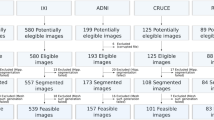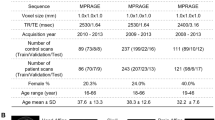Abstract
Although normal homologous brain structures are approximately symmetrical by definition, they also have shape differences due to e.g. natural ageing. On the other hand, neurodegenerative conditions induce their own changes in this asymmetry, making them more pronounced or altering their location. Identifying when these alterations are due to a pathological deterioration is still challenging. Current clinical tools rely either on subjective evaluations, basic volume measurements or disease-specific deep learning models. This paper introduces a novel method to learn normal asymmetry patterns in homologous brain structures based on anomaly detection and representation learning. Our framework uses a Siamese architecture to map 3D segmentations of left and right hemispherical sides of a brain structure to a normal asymmetry embedding space, learned using a support vector data description objective. Being trained using healthy samples only, it can quantify deviations-from-normal-asymmetry patterns in unseen samples by measuring the distance of their embeddings to the center of the learned normal space. We demonstrate in public and in-house sets that our method can accurately characterize normal asymmetries and detect pathological alterations due to Alzheimer’s disease and hippocampal sclerosis, even though no diseased cases were accessed for training. Our source code is available at https://github.com/duiliod/DeepNORHA.
Access this chapter
Tax calculation will be finalised at checkout
Purchases are for personal use only
Similar content being viewed by others
References
ADNI: Alzheimer’s disease neuroimaging initiative. http://adni.loni.usc.edu/ Accessed Feb. 9 2023
IXI dataset website. http://brain-development.org/ixidataset/ Accessed Feb. 9 2023
Ardekani, B., et al.: Sexual dimorphism and hemispheric asymmetry of hippocampal volumetric integrity in normal aging and Alzheimer disease. Am. J. Neuroradiol. 40(2), 276–282 (2019)
Bernasconi, N., et al.: Mesial temporal damage in temporal lobe epilepsy: a volumetric MRI study of the hippocampus, amygdala and parahippocampal region. Brain 126(2), 462–469 (2003)
Borchert, R., et al.: Artificial intelligence for diagnosis and prognosis in neuroimaging for dementia; a systematic review. medRxiv 2021–12 (2021)
Csernansky, J.G., et al.: Abnormalities of thalamic volume and shape in schizophrenia. Am. J. Psychiatry 161(5), 896–902 (2004)
Fu, Z., et al.: Altered neuroanatomical asymmetries of subcortical structures in subjective cognitive decline, amnestic mild cognitive impairment, and alzheimer’s disease. J. Alzheimers Dis. 79(3), 1121–1132 (2021)
Goubran, M., et al.: Hippocampal Segmentation for Brains with Extensive Atrophy Using Three-dimensional Convolutional Neural Networks. Tech. rep, Wiley Online Library (2020)
Herbert, M.R., et al.: Brain asymmetries in autism and developmental language disorder: a nested whole-brain analysis. Brain 128(1), 213–226 (2005)
Herzog, N.J., Magoulas, G.D.: Brain asymmetry detection and machine learning classification for diagnosis of early dementia. Sensors 21(3), 778 (2021)
Li, A., Li, F., Elahifasaee, F., Liu, M., Zhang, L.: Hippocampal shape and asymmetry analysis by cascaded convolutional neural networks for Alzheimer’s disease diagnosis. Brain Imag. Behav. 15(5), 2330–2339 (2021). https://doi.org/10.1007/s11682-020-00427-y
Liu, C.F., et al.: Using deep Siamese neural networks for detection of brain asymmetries associated with Alzheimer’s disease and mild cognitive impairment. Magn. Reson. Imaging 64, 190–199 (2019)
Low, A., et al.: Asymmetrical atrophy of thalamic Subnuclei in Alzheimer’s disease and amyloid-positive mild cognitive impairment is associated with key clinical features. Alzheimer’s Dementia: Diagnosis, Assess. Disease Monit. 11(1), 690–699 (2019)
Marcus, D.S., et al.: Open access series of imaging studies: longitudinal MRI data in nondemented and demented older adults. J. Cogn. Neurosci. 22(12), 2677–2684 (2010)
Oktay, O., et al.: Anatomically constrained neural networks (ACNNS): application to cardiac image enhancement and segmentation. IEEE Trans. Med. Imaging 37(2), 384–395 (2017)
de Oliveira, A., et al.: Defining multivariate normative rules for healthy aging using neuroimaging and machine learning: an application to Alzheimer’s disease. J. Alzheimers Dis. 43(1), 201–212 (2015)
Park, B.y, et al.: Topographic divergence of atypical cortical asymmetry and atrophy patterns in temporal lobe epilepsy. Brain 145(4), 1285–1298 (2022)
Pedraza, O., Bowers, D., Gilmore, R.: Asymmetry of the hippocampus and amygdala in MRI volumetric measurements of normal adults. JINS 10(5), 664–678 (2004)
Penny, W.D., et al.: Statistical parametric mapping: the analysis of functional brain images. Elsevier (2011)
Princich, J.P., et al.: Diagnostic performance of MRI volumetry in epilepsy patients with hippocampal sclerosis supported through a random forest automatic classification algorithm. Front. Neurol. 12, 613967 (2021)
Richards, R., et al.: Increased hippocampal shape asymmetry and volumetric ventricular asymmetry in autism spectrum disorder. NeuroImage: Clin. 26, 102207 (2020)
Ruff, L., et al.: Deep one-class classification. In: ICML, pp. 4393–4402. PMLR (2018)
Schölkopf, B., et al.: Support vector method for novelty detection. Adv. Neural. Inform. Process. Syst. 12 (1999)
Tortora, G.J., Derrickson, B.H.: Principles of anatomy and physiology. John Wiley & Sons (2018)
van Tulder, G.: elasticdeform: Elastic deformations for n-dimensional images (2021)
Wachinger, C., et al.: Whole-brain analysis reveals increased neuroanatomical asymmetries in dementia for hippocampus and amygdala. Brain 139(12), 3253–3266 (2016)
Woolard, A.A., Heckers, S.: Anatomical and functional correlates of human hippocampal volume asymmetry. Psych. Res.: Neuroimag. 201(1), 48–53 (2012)
Zhang, Z., Deng, X.: Anomaly detection using improved deep SVDD model with data structure preservation. Pattern Recogn. Lett. 148, 1–6 (2021)
Acknowledgments
This study was funded by PIP GI 2021-2023 0102472 (CONICET) and PICTs 2019-00070, 2020-00045 and 2021-00023 (Agencia I+D+i).
Author information
Authors and Affiliations
Corresponding author
Editor information
Editors and Affiliations
1 Electronic supplementary material
Below is the link to the electronic supplementary material.
Rights and permissions
Copyright information
© 2023 The Author(s), under exclusive license to Springer Nature Switzerland AG
About this paper
Cite this paper
Deangeli, D., Iarussi, E., Princich, J.P., Bendersky, M., Larrabide, I., Orlando, J.I. (2023). Learning Normal Asymmetry Representations for Homologous Brain Structures. In: Greenspan, H., et al. Medical Image Computing and Computer Assisted Intervention – MICCAI 2023. MICCAI 2023. Lecture Notes in Computer Science, vol 14227. Springer, Cham. https://doi.org/10.1007/978-3-031-43993-3_8
Download citation
DOI: https://doi.org/10.1007/978-3-031-43993-3_8
Published:
Publisher Name: Springer, Cham
Print ISBN: 978-3-031-43992-6
Online ISBN: 978-3-031-43993-3
eBook Packages: Computer ScienceComputer Science (R0)





